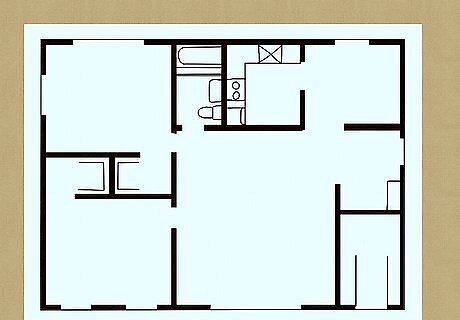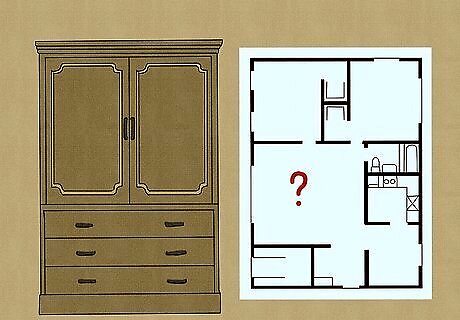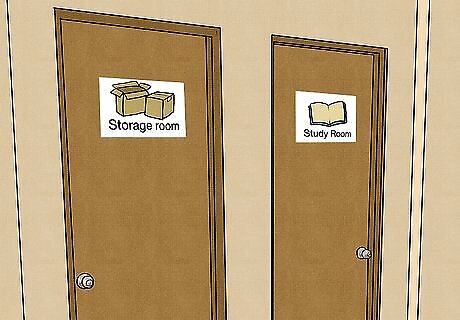
views
Deciding What to Keep

Purge your closets and storage rooms. Whether you're moving to a brand new home or someone else is moving into yours, you're probably going to need all the space you can get. Set aside time to pull everything out of your closets and storage areas, and all those nooks and crannies where you might be stashing stuff you don't use too often. Figure out what you need and what you don't, and make a plan to get rid of the possessions you don't need right away, so you can move on to the next step. Make three piles: "keep," "give away," and "not sure." You can go back to the "not sure" pile if you end up having more space than you thought you would. Take a look at your items and think about how often you use them. A good rule of thumb is to get rid of anything you haven't used in over a year. Having a yard sale is a great way to get rid of unwanted possessions and make some money in the process. Make sure to list your yard sale on Craigslist so people know you're having it. Yard sales are most popular in the spring, summer, and fall when the weather's nice. What you don't sell, you can donate. Remember it is much easier to get rid of things before you pack and move. Your merge will be easier if you make the decisions before you start squeezing in items that don't work.

Get rid of duplicates. One of the most difficult parts of merging two households is deciding which possession to keep when you and the person you're moving in with both have something. Depending on how much space you have, you'll probably have to give away some large pieces of furniture as well as smaller items, like kitchen supplies. Who needs two toaster ovens? Sit down together and make a list of all the duplicates, then decide which items are in the best condition and worth keeping. Here are a few items that you might need to consider: Furniture: beds, dressers, side tables, couches, kitchen tables, chairs, etc. Appliances: blenders, toasters, washers, dryers, coffee makers, etc. Kitchen supplies: can openers, wine openers, pots, pans, baking supplies, etc. Extra linens: sheets, towels, etc.

List your “must-haves.” Some items have strong sentimental value, and no matter how little sense it makes to keep them, you simply must have them around. Get together with your partner and make a list of your "must-haves." If some of your must-haves are large items that will require a lot of space, have a conversation about where they will go and whether it makes sense to keep them. Make sure your list isn’t three pages longer than your partner’s. You each get an equal say when it comes to "must-haves." This is an exercise in compromise. Limit your must-haves to things you do need, then go back and see which “wants” will fit in the new space, too.

Account for clothes and personal items. Consider where you will store these since you'll have less space in your merged household. You and your partner will both need a plan for where you will keep these things. You may be used to free rein with closet space before the merge. Now you may need to rotate seasonal items and store some items that aren't used so everyone has space. Consider boxing up or using vacuum compaction bags to store things you don't wear often. Organize your files and records. Determine what is safe to shred if you have multiple years of financial records. Get rid of or store any items you don't want to become common property. Since you're living together you can't expect the same privacy and the ability to keep certain items secret. If you've got anything embarrassing you should think twice before taking it.

Discuss your expectations before you begin. Merging two households might seem like a relatively straightforward task, a question of fitting lives and possessions together in the same space like puzzle pieces. The process can get pretty intense since it might require giving up some treasures. Adapting your lifestyle to fit with someone else's is a learning process that requires a lot of compromises. Before you start the merge, have a conversation with the person you're moving in with to go over all the big decisions and prevent things from getting too emotional or tense. Talk about what vision you have for the new household. How will the new home look? Will each room have a combination of both of your possessions? Talk about the possessions you both cherish. Is there something you assume your partner will give up? Is there something you don't want to give up? Get it all out there right away.
Planning Room Schemes

Draw a floor plan. This might seem like a bit of a hassle, but it will make your life a lot easier when you start moving into a new place or when someone else is moving into yours. A floor plan is a drawing or illustration of the floor space of each room in your house, as viewed from above. Your drawing doesn't have to be a work of art; just create a to-scale sketch of each room. Include doors, windows and radiators, if present so you know where furniture can be positioned. Measure the rooms in your new space. Write the measurements of the different rooms along the edges of the sketched walls. This way you can figure out what will fit where. Include the windows, doors, cabinets, the kitchen island, and other features that might affect how you arrange furniture in the room. Take pictures as well, so you'll remember the little details that could help you decide where to put things.

Decide where the large furniture will go. Before you even pack it up and start moving it, determine where you want each piece of furniture to be positioned. That way you can put it where it's supposed to go as soon as you move it into the house, rather than grouping everything in the front room and trying to figure out where it should go. Measure the furniture to determine where it will fit. Check your drawing of the floor plan and visualize how each piece of furniture will look. Keep swatches cut from the underneath of couches, chairs, and upholstered pieces. It will be easier to tell if items match or not before having to move them. Think about furniture pieces individually instead of their current arrangement. Follow common decorating rules in terms to help you pleasingly arrange things. For example, couches should be surrounded by a little space on all sides. In the bedroom, your bed should be the main focus, rather than shoved in a corner.

Find a decorating scheme that merges your tastes. Whether you're moving together into a brand new space or one of your existing homes, decide on a new decorating scheme that will tie all of your possessions together into a cohesive home. You might want to paint the walls, install new light fixtures, get new curtains, and so on to make the space feel like it belongs to the whole family, and not just one person. See if each person in the house can get some space of his or her own. Decide which rooms will be "family rooms" and aim to have them reflect the personalities of the entire household. Consider getting furniture recovered. A good upholstery shop can not only change the fabric but can add or remove padding to change the shape. You'll have a chance to pick fabrics together and there's a better chance of finding something that ties your taste together.

Box everything up by room. Now it's finally time to get ready to move by putting your possessions inboxes. Go through your home room by room and box things up. Make sure fragile items are packed with soft materials to keep them safe during transit. If you're having movers help you merge your two households, make sure to give them clear directions about where everything should go. Label the boxes by color, and have the person you're moving in with doing the same. For example, items that belong in the living room could have a purple label, items for the kitchen could have a red label, and so on. Have the boxes delivered to the appropriate room in the new home.
Creating a New Home Together

Respect each other’s preferences. Realize that merging two households means making compromises. Your lifestyles are about to change, but that doesn't have to be a negative thing. It's very exciting. Help each other make the transition easier by respecting each other's ideas and talking everything out if you have a conflict. Don’t start things off on the wrong foot by being stubborn about little things that don’t matter. If you have three hand mixers, for example, have the mentality that you're willing to give yours up for the sake of the household. Don’t fight about whether to keep heirlooms. If your partner wants to keep the table his grandfather made, don't fight about it, even if you think the thing is hideous. If it's a family heirloom, it should stay in the family.

Be open-minded about the result. The new household isn't going to be like your old one, and you shouldn't expect it or want it to be. You're merging your tastes with your partner's to create something new and fresh. With careful planning, you can create a new space that you both enjoy. Strive for a new and improved merged household, rather than trying to replicate the old house. If the person is moving into your home, be willing to make big changes. Remember that you'll need to make mutual decisions about how to improve the space from now on.

Get the children involved. Merging two households can be hard on kids. If children are involved in your household merge, they should be involved in the decision-making. Merging households might make them feel nervous, and it's really helpful if they feel they have a say in what their new space will be like. Get the kids involved in packing, decorating, and creating a new personal space for themselves. Let kids decide which toys to keep, and which to give away. Get kids excited about the new and improved space. Tell them moving will be an adventure. Try to keep the kids' sleeping arrangements similar to what they were before the merge.

Make a personalized plan that meets your needs. Merging households means merging lifestyles. Think about all the factors in both of your lives that will be affected by the merge. Have a plan for accommodating each other's hobbies, pets, and so on. If you have pets, where will their new hangouts be? Where will they sleep? Where will you keep their food and water dishes? Figure out who gets what closets and storage space before you move in, so you can keep your new household organized from the get-go. Make a plan for sharing “extra” spaces, like a nook that can be a study, craft room, or reading nook depending on how you want to use it.

Share the space and don't dictate. Don't make the experience regretful by being a control freak. Make sure everyone has their contribution to the home. One person shouldn't take over. Both of you should feel at home. Allow the person with fewer items to contribute by giving them the freedom to select decorations, layout, or even to decorate their personal space. For example office, reading nook, gym area, etc.




















Comments
0 comment